
Brittle stars, serpent stars, or ophiuroids are echinoderms in the class Ophiuroidea, closely related to starfish. They crawl across the sea floor using their flexible arms for locomotion. The ophiuroids generally have five long, slender, whip-like arms which may reach up to 60 cm (24 in) in length on the largest specimens.

Athanasios "Sakis" Tolis is a Greek musician best known as the vocalist and rhythm guitarist of Rotting Christ. He is also known as Necromayhem.

The Ophiurida are an order of echinoderms within the class Ophiuroidea. It includes the vast majority of living brittle stars.

Ophiactidae are a family of brittle stars.
Ophiocanops fugiens is a living species in the brittle star family Ophiocanopidae. Though once considered to be the only one living species in this brittle star family, recent research has brought to light three specimens of Ophiocanops that differ substantially from O. fugiens. It has been regarded as the most primitive brittle star, close to Paleozoic forms, though other authors have disagreed with the view. Classification of O. fugiens is highly argued. Ophiocanops is usually placed in the order Oegophiurida or regarded as a genus incertae sedis or even given its own subclass Oegophiuridea. Some recent data suggest its relationship to the extant family Ophiomyxidae.

Ophiotrichidae are a family of brittle stars within the suborder Gnathophiurina.
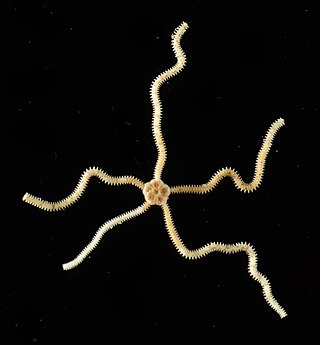
Amphiodia pulchella is a species of brittle star belonging to Amphiuridae, a diverse family of the Ophiurida order.
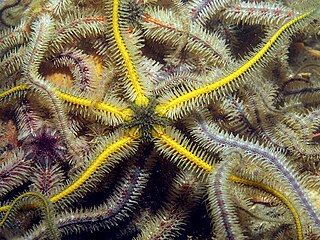
Ophiothrix is a large genus of brittle stars (Ophiuroidea) found in oceans worldwide from tropics to Arctic and Antarctic regions. At present a total of 93 Ophiothrix species have been recognized. It is considered as one of the most interesting genera because of the presence of its brilliant colors and associations with coral and sponges as well. This genus has been labelled particularly difficult with respect to taxonomy, due to a high degree of variability in characters that are described is a morphological aspect.

Ophiactis is a genus of brittle stars (Ophiuroidea).

Astrobrachion adhaerens is a basket star in the Euryalidae family. Along with A. constrictum, it is one of only two species in the genus Astrobrachion. Both species live in association with soft corals in moderately deep water. It is endemic to the west, north and east coasts of Australia, the Kermadec Islands and Lord Howe Island.

Ophiohamus is a genus of brittle stars in the family Ophiacanthidae from New Caledonia. Timothy D. O'Hara and Sabine Stöhr circumscribed and named the genus in 2006; they described the type species Ophiohamus nanus in the same work. A second species, Ophiohamus georgemartini, was described by O'Hara and Caroline Harding in 2015. As of 2018, those are the only two species recognized in this genus.
Paleontology or palaeontology is the study of prehistoric life forms on Earth through the examination of plant and animal fossils. This includes the study of body fossils, tracks (ichnites), burrows, cast-off parts, fossilised feces (coprolites), palynomorphs and chemical residues. Because humans have encountered fossils for millennia, paleontology has a long history both before and after becoming formalized as a science. This article records significant discoveries and events related to paleontology that occurred or were published in the year 2018.
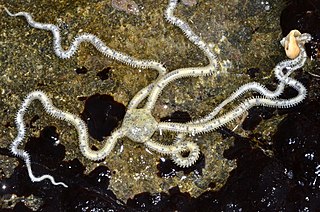
Amphiodia occidentalis, the long-armed brittle star, is a species of brittle star belonging to the family Amphiuridae. It is found in the Eastern Pacific coast from Alaska to USA, often on the seafloor within intertidal and subtidal zones. Within these areas, it is often found buried a few centimeters under the sand with 2 or 3 arms extending through the surface.
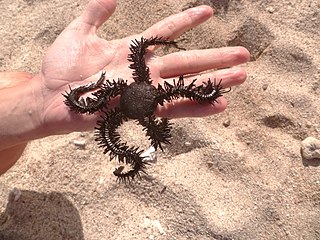
Ophiacanthida is an order of echinoderms belonging to the class Ophiuroidea.
Ophiojura is a genus of brittle star in its own family, Ophiojuridae. It has only one known species, Ophiojura exbodi, collected by the EXBODI expedition from Banc Durand seamount off New Caledonia in 2011 at a depth of 360–460 m (1,200–1,500 ft). The prefix 'Ophio' comes form the Ancient Greek word for serpent, and 'jura' is derived from the Jura Mountains, which lent its name to the Jurassic period.

Melusinaster is a genus of basket stars from the Jurassic period described by Thuy and Stöhr in 2018. Fossil specimens from areas throughout Germany were used to describe the genus. The individuals described with small ophiuroids with arched, crescent-shaped arm plates, articulations in the spine made of muscle and nerve openings, and no tubercles or spurs on the outer surfaces of the arm plates.
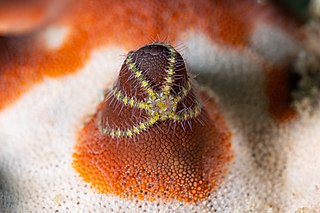
Ophiothela mirabilis is a species of ophiuroid brittle star within the family Ophiotrichidae. O. mirabilis is an epizoic species which have a non-parasitic relationship with host sponges or gorgonians. Although native to the Pacific Ocean, it has invaded the Caribbean and southwestern Atlantic since late 2000. Many of its characteristics, including reproduction and diet, allow O. mirabilis opportunities to quickly propagate and spread through habitats.

Hemipholis is a genus of brittle stars.

Ophiotomidae is a family of brittle stars. It was originally introduced as a subfamily Ophiotominae under the family Ophiacanthidae. The family has a worldwide distribution.













